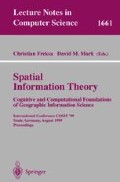Abstract
Where some have attempted to apply cognitive methods to the study of geography, the present paper is designed to serve as a starting point for applying methods of geographic ontology to the phenomena of cognition. Agglomerations are aggregates of entities that are dispersed through space on geographic scales. Examples include: plagues, biological species, major world religions. The paper applies standard mereotopological theories of spatial regions to agglomerations in this sense. It offers the beginnings of a general theory of the relations between social, cultural, ethnic and religious agglomerations on the one hand and territorially demarcated spatial objects on the other. In this way it serves as the basis for a general ontological theory of types of human groups and also of types of conflict between these groups. At the same time it provides ontological foundations for the epidemiological study of cognitive phenomena, and especially of cognitive phenomena in the sociopolitical realm.
Access this chapter
Tax calculation will be finalised at checkout
Purchases are for personal use only
Preview
Unable to display preview. Download preview PDF.
References
Casati, R. and Varzi, A. C. 1999, Parts and Places: The Structures of Spatial Representation, Cambridge, MA, and London: MIT Press (Bradford Books).
Cohn, Anthony G., Bennett, Brandon, Gooday, John and Gotts, Nicholas Mark 1997, “Qualitative Spatial Representation and Reasoning with the Region Connection Calculus”, Geoinformatica, 1, 1–44.
Damuth, J., 1985, ‘Selection among “Species”: A Formulation in Terms of Natural Functional Units’, Evolution 39, 1132–46.
Eriksen, Thomas Hylland 1993, Ethnicity and Nationalism. Anthropological Perspectives, London: Pluto Press.
Fine, Kit 1995, “Part Whole,” in: Barry Smith and David W. Smith (eds.), The Cambridge Companion to Husserl, Cambridge and New York: Cambridge University Press, 463–485.
Hornsby, Kathleen and Egenhofer, Max 1997, “Qualitative Representation of Change”, in Stephen C. Hirtle and Andrew U. Frank (eds.), Spatial Information Theory. A Theoretical Basis for GIS (International Conference COSIT’ 97, Laurel Highlands, Pennsylvania, October 1997), Springer Lecture Notes in Computer Science 1329, 15–33.
Hornsby, Kathleen and Egenhofer, Max 1998, “Identity-Based Change Operations for Composite Objects”, SDH’ 98. Proceedings of the 8th International Symposium on Spatial Data Handling, T. K. Poiker and N. Chrisman, eds., Vancouver: International Geographic Union, 202–213.
Lewin, Kurt 1917, “Kriegslandschaft)”, Zeitschrift für angewandte Psychologie, 12, 440–447.
Randell, D. A., Cui, Z. and Cohn, A. G. 1992, “A Spatial Logic based on Regions and Connection”, Proceedings of the 3rd International Conference on Knowledge Representation and Reasoning, Boston, October 1992 (http://www.scs.leeds.ac.uk/spacenet/publications.html).
Rugg, R., Egenhofer, M. and Kuhn, W. 1997, “Formalizing Behavior of Geographic Feature Types,” Geographical Systems, 4(2), 159–179 (http://www.spatial.maine.edu/~max/RJ24.html).
Schelling, Thomas 1978, Micromotives and Macrobehavior, New York/London: Norton.
Searle, John R. 1995, The Construction of Social Reality, New York: Free Press.
Smith, Barry 1991, “Relevance, Relatedness and Restricted Set Theory”, in G. Schurz and G. J. W. Dorn, eds., Advances in Scientific Philosophy, Amsterdam/Atlanta: Rodopi, 45–56.
Smith, Barry 1994, “Fiat Objects,” in N. Guarino, S. Pribbenow, and L. Vieu. (eds.), Parts and Wholes: Conceptual Part-Whole Relations and Formal Mereology. Proceedings of the ECAI94 Workshop, Amsterdam: ECCAI, 15–23.
Smith, Barry 1995, “On Drawing Lines on a Map,” in A. U. Frank and W. Kuhn. (eds.), Spatial Information Theory. A Theoretical Basis for GIS, Berlin and Heidelberg: Springer-Verlag, 475–84 (http://wings.buffalo.edu/philosophy/faculty/smith/articles/drawing.html).
Smith, Barry 1995a, “More Things in Heaven and Earth”, Grazer Philosophische Studien, 50, 187–201 (http://wings.buffalo.edu/philosophy/faculty/smith/articles/meinong.html).
Smith, Barry 1996, “Mereotopology: A Theory of Parts and Boundaries,” Data and Knowledge Engineering 20, 1996, 287–304.
Smith, Barry 1997a, “The Cognitive Geometry of War”, in Peter Koller and Klaus Puhl (eds.), Current Issues in Political Philosophy: Justice in Society and World Order, Vienna: Hölder-Pichler-Tempsky, 394–403 (http://wings.buffalo.edu/philosophy/faculty/smith/articles/bosnia.html).
Smith, Barry (ed.) 1982, Parts and Moments. Studies in Logic and Formal Ontology, Munich: Philosophia.
Taylor, R. B. 1988, Human Territorial Functioning. An Empirical, Evolutionary Perspective on Individual and Small Group Territorial Cognitions, Behaviors and Consequences, Cambridge: Cambridge University Press.
Talmy, Leonard 1988, “Force Dynamics in Language and Cognition”, Cognitive Science, 12, 49–100.
Author information
Authors and Affiliations
Editor information
Editors and Affiliations
Rights and permissions
Copyright information
© 1999 Springer-Verlag Berlin Heidelberg
About this paper
Cite this paper
Smith, B. (1999). Agglomerations. In: Freksa, C., Mark, D.M. (eds) Spatial Information Theory. Cognitive and Computational Foundations of Geographic Information Science. COSIT 1999. Lecture Notes in Computer Science, vol 1661. Springer, Berlin, Heidelberg. https://doi.org/10.1007/3-540-48384-5_18
Download citation
DOI: https://doi.org/10.1007/3-540-48384-5_18
Published:
Publisher Name: Springer, Berlin, Heidelberg
Print ISBN: 978-3-540-66365-2
Online ISBN: 978-3-540-48384-7
eBook Packages: Springer Book Archive

